Variability of word-final /ɔ̃/ in Greater Poland Polish
Poznań Linguistic Meeting 2018
Kamil Kaźmierski & Marta Szlandrowicz
September 13th, 2018
Frequency in Favoring Conditioning (FFC)
Is knowledge of variation stored?
- Abstractionists: No, only abstract units are stored (Levelt et al. 1999).
Is knowledge of variation stored?
Abstractionists: No, only abstract units are stored (Levelt et al. 1999).
Rich storage: So what about frequency effects, such as Bybee (2000)?
Is knowledge of variation stored?
Abstractionists: No, only abstract units are stored (Levelt et al. 1999).
Rich storage: So what about frequency effects, such as Bybee (2000)?
A: Well, word-form frequencies are available for online computation.
Is knowledge of variation stored?
Abstractionists: No, only abstract units are stored (Levelt et al. 1999).
Rich storage: So what about frequency effects, such as Bybee (2000)?
A: Well, word-form frequencies are available for online computation.
RS: OK, but what about lemma frequency effects, like time vs. thyme (Gahl 2008)?
Is knowledge of variation stored?
Abstractionists: No, only abstract units are stored (Levelt et al. 1999).
Rich storage: So what about frequency effects, such as Bybee (2000)?
A: Well, word-form frequencies are available for online computation.
RS: OK, but what about lemma frequency effects, like time vs. thyme (Gahl 2008)?
A: Uhm...
Is knowledge of variation stored?
Abstractionists: No, only abstract units are stored (Levelt et al. 1999).
Rich storage: So what about frequency effects, such as Bybee (2000)?
A: Well, word-form frequencies are available for online computation.
RS: OK, but what about lemma frequency effects, like time vs. thyme (Gahl 2008)?
A: Uhm...
RS: And what about typical environment effects like Eddington & Channer (2010), Brown & Raymond (2012) or Seyfarth (2014)?
Is knowledge of variation stored?
Abstractionists: No, only abstract units are stored (Levelt et al. 1999).
Rich storage: So what about frequency effects, such as Bybee (2000)?
A: Well, word-form frequencies are available for online computation.
RS: OK, but what about lemma frequency effects, like time vs. thyme (Gahl 2008)?
A: Uhm...
RS: And what about typical environment effects like Eddington & Channer (2010), Brown & Raymond (2012) or Seyfarth (2014)?
A: ...
Transition to next slide: "So what are these effects?"
Bybee, Joan. 2000. The Phonology of the lexicon: Evidence from Lexical Diffusion.
~lexical frequency has affected pre-r schwa-deletion in English, and t/d deletion in English
Effect of typical environment
- Eddington & Channer (2010): word-final /t/ glottalizes more often in words that typically are followed by consonant-initial words
Effect of typical environment
Eddington & Channer (2010): word-final /t/ glottalizes more often in words that typically are followed by consonant-initial words
Brown & Raymond (2012): words that typically occur after non-high vowels more often lost word-inifial /f/
Effect of typical environment
Eddington & Channer (2010): word-final /t/ glottalizes more often in words that typically are followed by consonant-initial words
Brown & Raymond (2012): words that typically occur after non-high vowels more often lost word-inifial /f/
Seyfarth (2014): typically predictable words reduce even in unpredictable contexts
Effect of typical environment
Eddington & Channer (2010): word-final /t/ glottalizes more often in words that typically are followed by consonant-initial words
Brown & Raymond (2012): words that typically occur after non-high vowels more often lost word-inifial /f/
Seyfarth (2014): typically predictable words reduce even in unpredictable contexts
Frequency in Favoring Conditioning (FFC) (Bybee 2017)
Such effects are pooled together in Bybee 2017 and, and she named the relevant factor 'FFC'
In this paper: FFC effect on a regional variant
Realization of /ɔ̃/ within words
| Realisation | Position | Example |
|---|---|---|
| [ɔw̃] | word-finally; before fricatives, except alveolo-palatal | idą [idɔw̃]; wąska [vɔw̃ska] |
| [ɔw̃] ~ [ɔj̃] | after a “hard” C, before alveolo-palatal fricatives | wąsik [vɔw̃ɕik] ~ [vɔj̃ɕik] |
| [ɔj̃] | after a “soft” C, before alveolo-palatal fricatives | (na) wiązie [vjɔj̃ʑe] |
| [ɔ] or [ɔ̃] | before l or w | plunąłem [plunɔwɛm] |
| [ɔm] | before bilabial stops or affricates | ząbek [zɔmbɛk] |
| [ɔn] | before dental stops or affricates | kąt [kɔnt] |
| [ɔn] or [ɔṇ] | before alveolar stops and affricates | rączka [rɔṇʨka] |
| [ɔɲ] | before alveolo-palatal affricates | piąć [pjɔɲt͡ʂ] |
| [ɔŋ] | before (post-palatal or) velar stops | mąka[mɔŋka] |
Realization of /ɔ̃/ within words
| Realisation | Position | Example |
|---|---|---|
| [ɔw̃] | word-finally; before fricatives, except alveolo-palatal | idą [idɔw̃]; wąska [vɔw̃ska] |
| [ɔw̃] ~ [ɔj̃] | after a “hard” C, before alveolo-palatal fricatives | wąsik [vɔw̃ɕik] ~ [vɔj̃ɕik] |
| [ɔj̃] | after a “soft” C, before alveolo-palatal fricatives | (na) wiązie [vjɔj̃ʑe] |
| [ɔ] or [ɔ̃] | before l or w | plunąłem [plunɔwɛm] |
| [ɔm] | before bilabial stops or affricates | ząbek [zɔmbɛk] |
| [ɔn] | before dental stops or affricates | kąt [kɔnt] |
| [ɔn] or [ɔṇ] | before alveolar stops and affricates | rączka [rɔṇʨka] |
| [ɔɲ] | before alveolo-palatal affricates | piąć [pjɔɲt͡ʂ] |
| [ɔŋ] | before (post-palatal or) velar stops | mąka[mɔŋka] |
before fricatives - realised with a glide
Realization of /ɔ̃/ within words
| Realisation | Position | Example |
|---|---|---|
| [ɔw̃] | word-finally; before fricatives, except alveolo-palatal | idą [idɔw̃]; wąska [vɔw̃ska] |
| [ɔw̃] ~ [ɔj̃] | after a “hard” C, before alveolo-palatal fricatives | wąsik [vɔw̃ɕik] ~ [vɔj̃ɕik] |
| [ɔj̃] | after a “soft” C, before alveolo-palatal fricatives | (na) wiązie [vjɔj̃ʑe] |
| [ɔ] or [ɔ̃] | before l or w | plunąłem [plunɔwɛm] |
| [ɔm] | before bilabial stops or affricates | ząbek [zɔmbɛk] |
| [ɔn] | before dental stops or affricates | kąt [kɔnt] |
| [ɔn] or [ɔṇ] | before alveolar stops and affricates | rączka [rɔṇʨka] |
| [ɔɲ] | before alveolo-palatal affricates | piąć [pjɔɲt͡ʂ] |
| [ɔŋ] | before (post-palatal or) velar stops | mąka[mɔŋka] |
before stops and affricates - realised with a homorganic stop
Realization of /ɔ̃/ within words
| Realisation | Position | Example |
|---|---|---|
| [ɔw̃] | word-finally; before fricatives, except alveolo-palatal | idą [idɔw̃]; wąska [vɔw̃ska] |
| [ɔw̃] ~ [ɔj̃] | after a “hard” C, before alveolo-palatal fricatives | wąsik [vɔw̃ɕik] ~ [vɔj̃ɕik] |
| [ɔj̃] | after a “soft” C, before alveolo-palatal fricatives | (na) wiązie [vjɔj̃ʑe] |
| [ɔ] or [ɔ̃] | before l or w | plunąłem [plunɔwɛm] |
| [ɔm] | before bilabial stops or affricates | ząbek [zɔmbɛk] |
| [ɔn] | before dental stops or affricates | kąt [kɔnt] |
| [ɔn] or [ɔṇ] | before alveolar stops and affricates | rączka [rɔṇʨka] |
| [ɔɲ] | before alveolo-palatal affricates | piąć [pjɔɲt͡ʂ] |
| [ɔŋ] | before (post-palatal or) velar stops | mąka[mɔŋka] |
before l or w - realised with plain oral vowel
Word-final /ɔ̃/ in Greater Poland Polish
Prescriptive norm:
[ɔw̃]
łodzią [ˈwɔdʑɔw̃]
‘boat-INS.SG’
Nasal stopping:
[ɔm]
łodzią [ˈwɔdʑɔm]
‘boat-INS.SG’
we will refer to as nasal stopping
Actual speakers show variation between the two variants.
łodzią [ˈwɔdʑɔw̃]
‘boat-INS.SG’
łodziom [ˈwɔdʑɔm]
‘boat-DAT.PL’
When the prescriptive norm is followed, such contrasts are maintained.
łodzią [ˈwɔdʑɔm]
‘boat-INS.SG’
łodziom [ˈwɔdʑɔm]
‘boat-DAT.PL’
When nasal stopping is used consistently, such contrasts are neutralized.
łodzią [ˈwɔdʑɔw̃]
‘boat-INS.SG’
łodziom [ˈwɔdʑɔw̃]
‘boat-DAT.PL’
When nasal stopping is avoided - such contrasts are also netrualized (through 'hypercorrection')
"Pomagamy dziecią / Oddajemy Jeżycą"
You could give more examples from Biedrzycki 1978
Change in progress?
Witaszek-Samborska (1985)
- nasal stopping is 'common' (powszechne) among educated speakers
- for 23 / 43 speakers stopping exclusive or almost exclusive variant
Kaźmierski et al. (in press)
- stopping rate among Poznań university students: 25%
- only for 3 out of 14 speakers prevalence > 50%
1) Don't read all numbers, stick to the gist: For Witaszek-Samborska stopping very frequent (only a little less for the iddle generation), Kaźmierski et al. - rather rare.
2) Current study: all speakers in the same age group, so the question of change can't be addressed directly (no real-time data available here).
3) Also reflect: perhaps different levels of formality/different elicitation tasks,
Education and formality
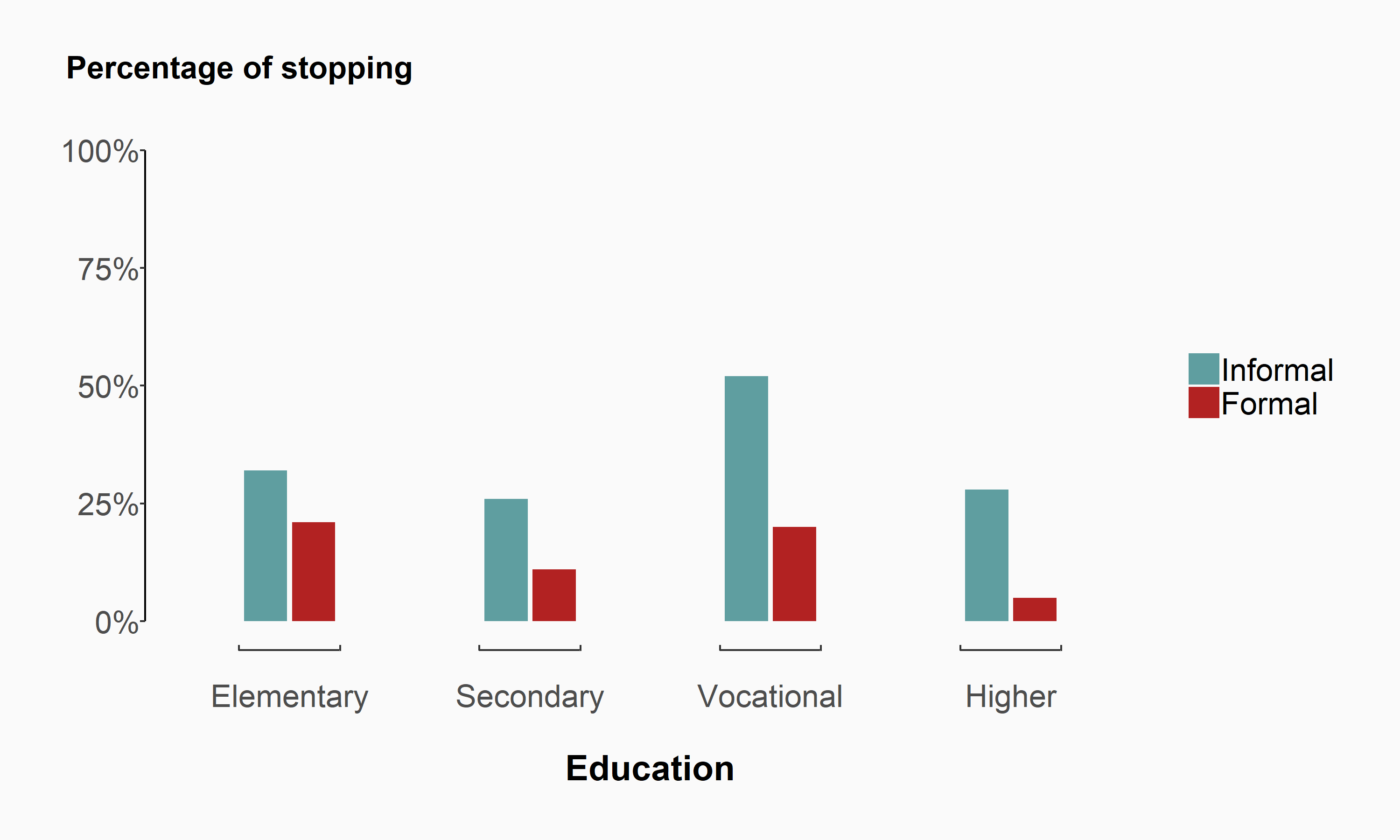
Baranowska, Karolina. 2018. "Nasal vowels in English and Polish. A comparative analysis and a sociolinguistic study". MA thesis, Adam Mickiewicz University.
1) The highest percentage of stopping overall in the Vocational group.
2) In the 'Higher' group, in 'Formal', stopping drops almost to zero (5%)
3) Style-shifting visible for all educational groups, perhaps except for primary
4) Present study: all subjects university students, formality the same for all
Research questions
RQ1 (Descriptive): Does the initial sound of following words influence the likelihood of nasal stopping?
Research questions
RQ1 (Descriptive): Does the initial sound of following words influence the likelihood of nasal stopping?
RQ2 (Theoretical): Does FFC influence the likelihood of nasal stopping?
FFC = Frequency in Favoring Conditioning
Method
Speakers (N = 64)
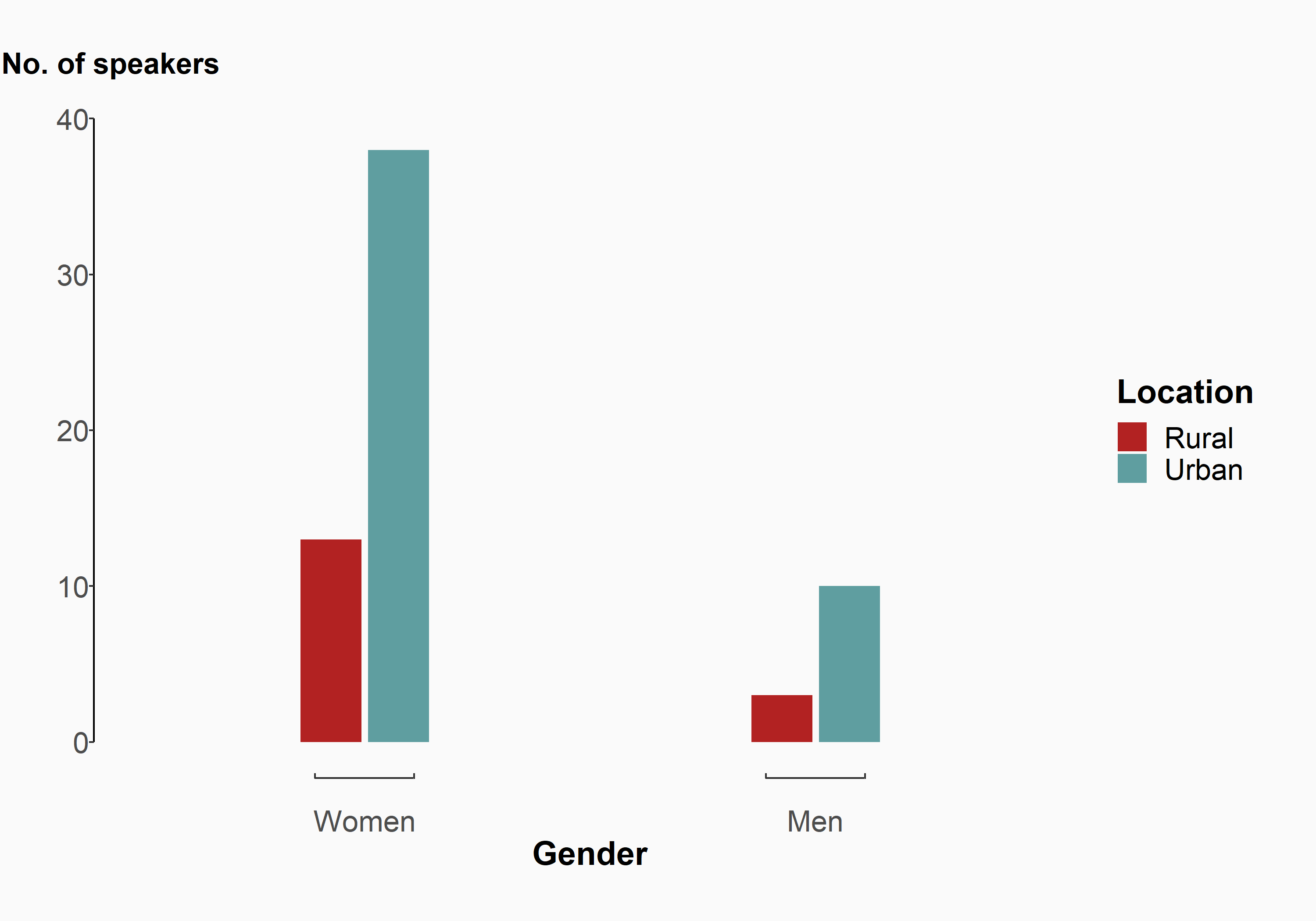


Coding
outcome: manually as glide or stop (= nasal stopping)
Coding
outcome: manually as glide or stop (= nasal stopping)pause: manually as present or absent
Coding
outcome: manually as glide or stop (= nasal stopping)pause: manually as present or absentFrequency in Favoring Conditioningfrom SUBTLEX-PL- no. of hits in favoring / in unfavoring conditioning
- lowest: piszą, różnią, mówią
- highest: traktują, przypominają, należą
Coding
outcome: manually as glide or stop (= nasal stopping)pause: manually as present or absentFrequency in Favoring Conditioningfrom SUBTLEX-PL- no. of hits in favoring / in unfavoring conditioning
- lowest: piszą, różnią, mówią
- highest: traktują, przypominają, należą
favoring_environment:- yes: są bloki /sɔ̃blɔki/
- no: są spoko /sɔ̃spɔkɔ/
Coding
outcome: manually as glide or stop (= nasal stopping)pause: manually as present or absentFrequency in Favoring Conditioningfrom SUBTLEX-PL- no. of hits in favoring / in unfavoring conditioning
- lowest: piszą, różnią, mówią
- highest: traktują, przypominają, należą
favoring_environment:- yes: są bloki /sɔ̃blɔki/
- no: są spoko /sɔ̃spɔkɔ/
frequencydiscretized based on SUBTLEX-PL- low: e.g. trzymają, amerykańską, biegają
- middle: e.g. całą, grupą, mieszkają
- high: e.g. są, tą, mają
/dɪˈskriːtʌɪzd/
Example 1: Nasalized glide [-ɔw̃]
mieszkają [-ɔw̃]

no discernible difference in intensity between a vowel and a glide
Example 2: Nasal stop [-ɔm]
moją [-ɔm]

Results
Nasal stopping rate: 53%
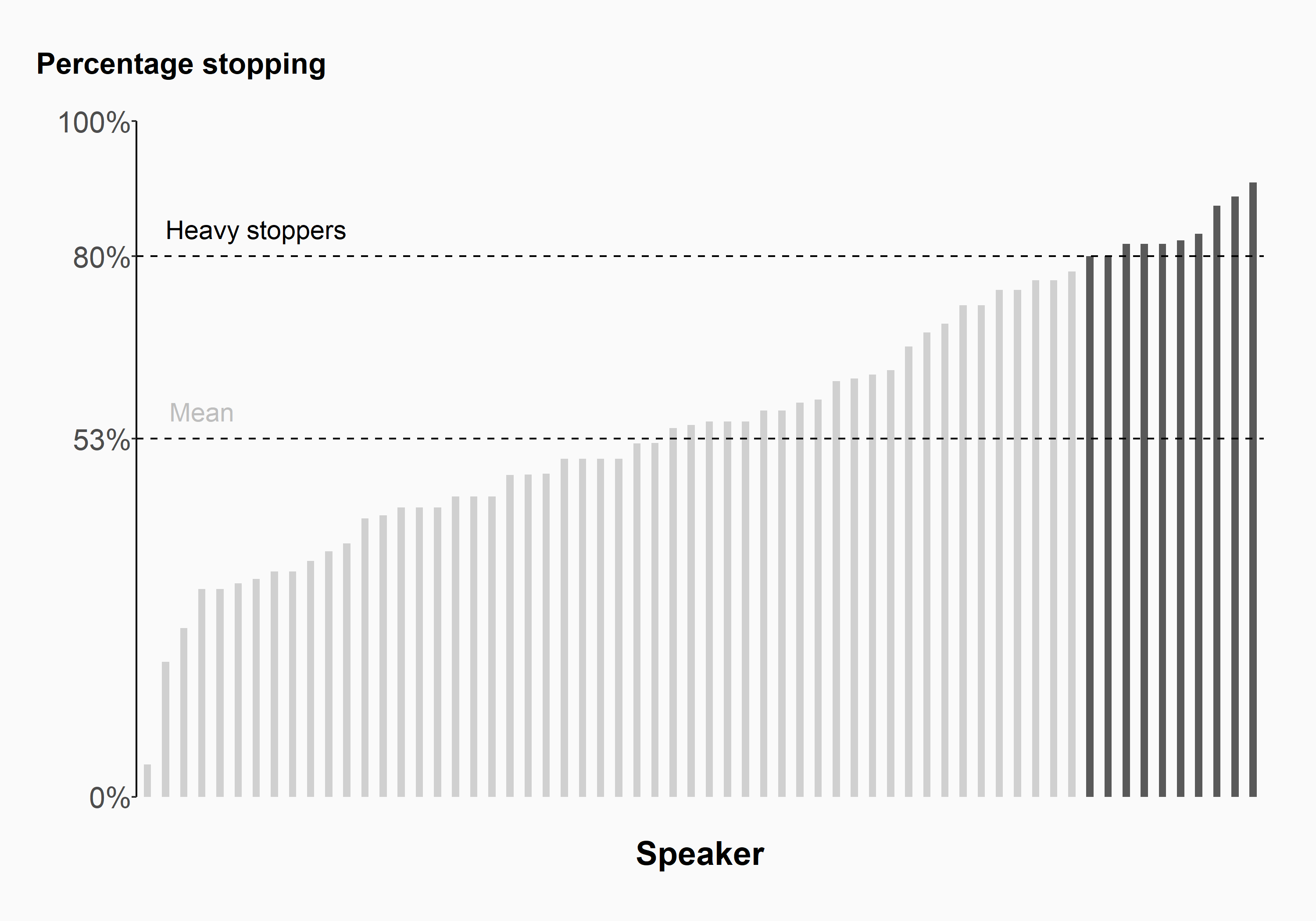
Little influence of location or gender
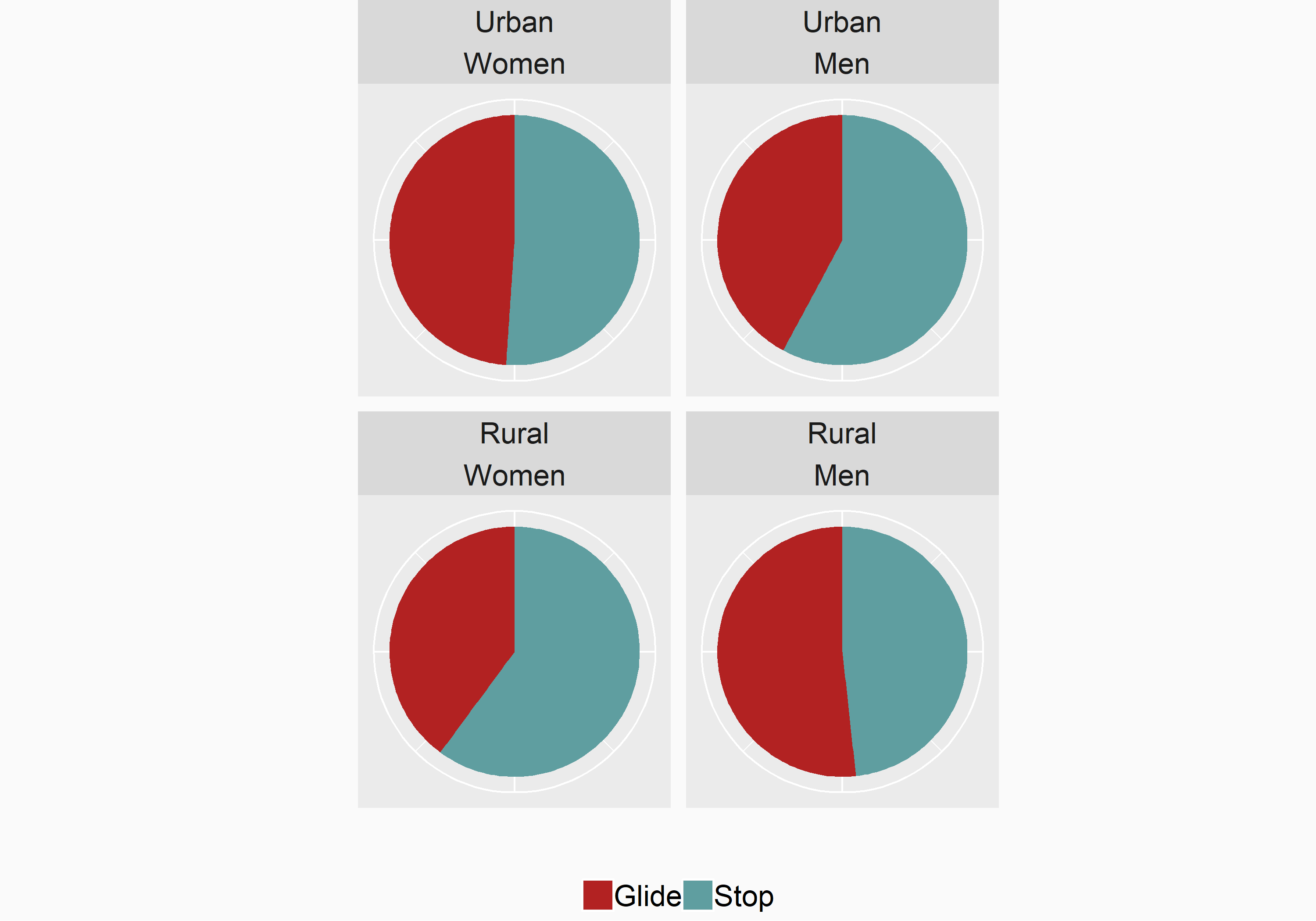
- the overall rate of nasal stopping around 50%, (higher than Baranowska - more informal??)
- location and gender don't seem to matter
Environment matters when no pause
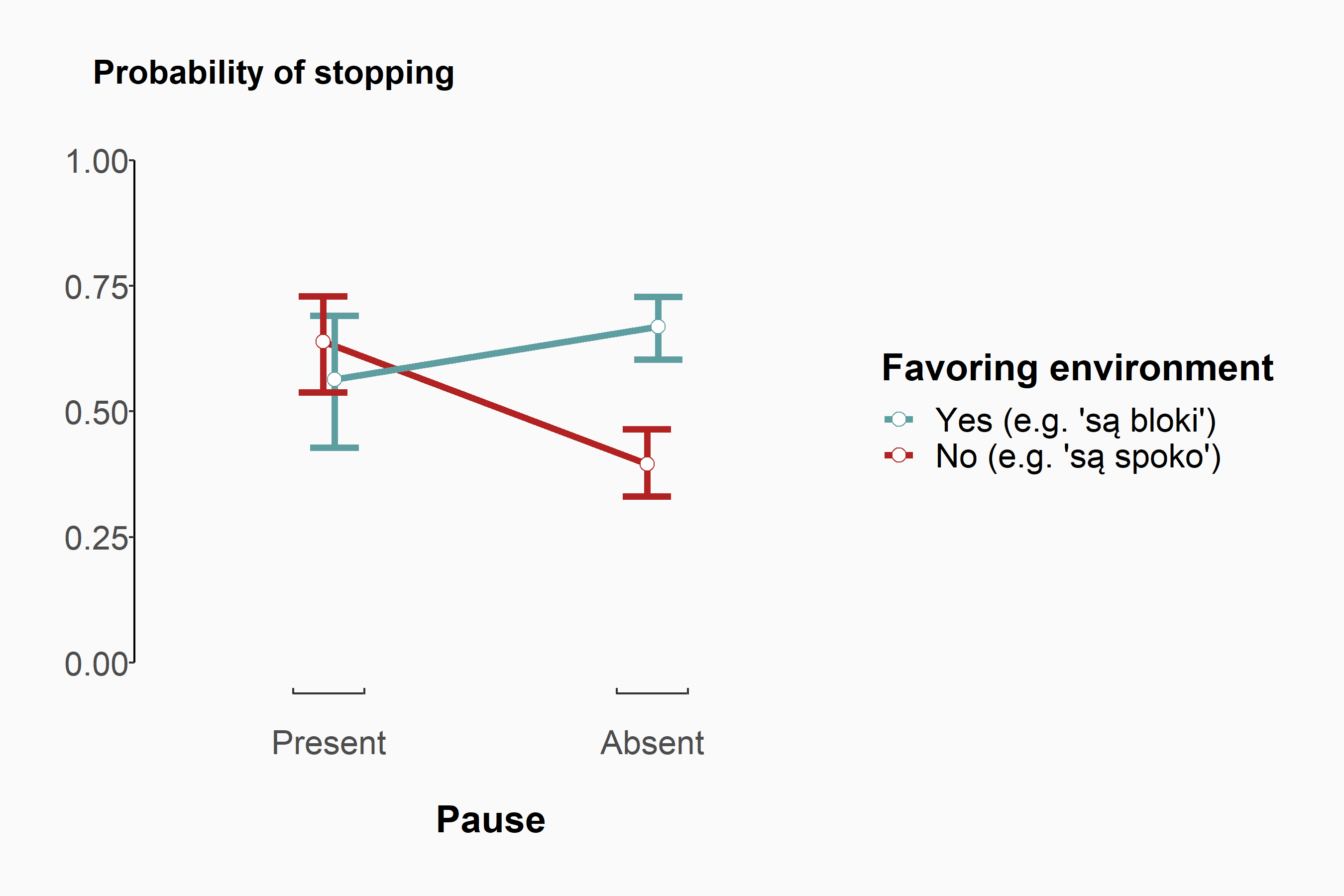
pauseyes:favoringyes β = -1.44, p < .001
FFC matters for low and mid freq. words

Frequency matters
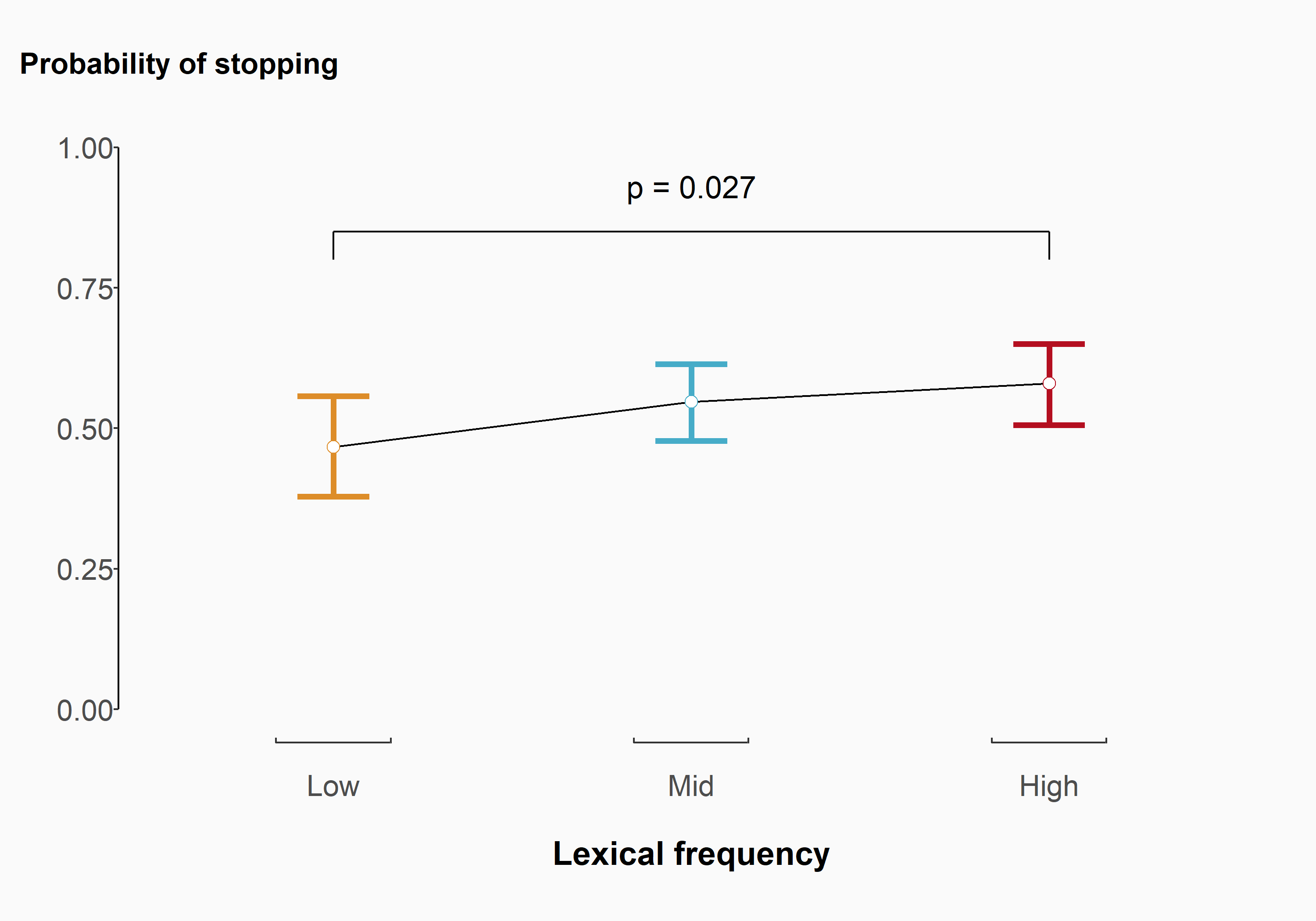
Conclusions
RQ1 (Descriptive): Does the initial sound of following words influence the likelihood of nasal stopping?
Conclusions
RQ1 (Descriptive): Does the initial sound of following words influence the likelihood of nasal stopping?
✓ Yes (but only when there is no pause)
Conclusions
RQ1 (Descriptive): Does the initial sound of following words influence the likelihood of nasal stopping?
✓ Yes (but only when there is no pause)
RQ2 (Theoretical): Does FFC influence the likelihood of nasal stopping?
Conclusions
RQ1 (Descriptive): Does the initial sound of following words influence the likelihood of nasal stopping?
✓ Yes (but only when there is no pause)
RQ2 (Theoretical): Does FFC influence the likelihood of nasal stopping?
✓ Yes (but in an interaction with lexical frequency)
Thank you!
Frequency in Favoring Conditioning affects probability of nasal stopping: evidence for rich storage.

kamil.kazmierski@wa.amu.edu.pl